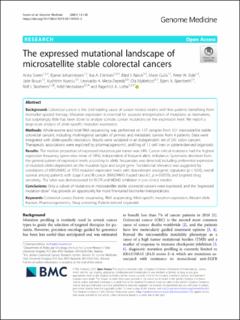| dc.contributor.author | Sveen, Anita | |
| dc.contributor.author | Johannessen, Bjarne | |
| dc.contributor.author | Eilertsen, Ina Andrassy | |
| dc.contributor.author | Røsok, Bård Ingvald | |
| dc.contributor.author | Gulla, Marie | |
| dc.contributor.author | Eide, Peter Andreas Wold | |
| dc.contributor.author | Bruun, Jarle | |
| dc.contributor.author | Kryeziu, Kushtrim | |
| dc.contributor.author | Meza, Leonardo Zepeda | |
| dc.contributor.author | Myklebost, Ola | |
| dc.contributor.author | Bjørnbeth, Bjørn Atle | |
| dc.contributor.author | Skotheim, Rolf I. | |
| dc.contributor.author | Nesbakken, Arild | |
| dc.contributor.author | Lothe, Ragnhild Adelheid | |
| dc.date.accessioned | 2022-02-07T12:51:29Z | |
| dc.date.available | 2022-02-07T12:51:29Z | |
| dc.date.created | 2022-01-11T10:34:33Z | |
| dc.date.issued | 2021 | |
| dc.identifier.issn | 1756-994X | |
| dc.identifier.uri | https://hdl.handle.net/11250/2977501 | |
| dc.description.abstract | Background
Colorectal cancer is the 2nd leading cause of cancer-related deaths with few patients benefiting from biomarker-guided therapy. Mutation expression is essential for accurate interpretation of mutations as biomarkers, but surprisingly, little has been done to analyze somatic cancer mutations on the expression level. We report a large-scale analysis of allele-specific mutation expression.
Methods
Whole-exome and total RNA sequencing was performed on 137 samples from 121 microsatellite stable colorectal cancers, including multiregional samples of primary and metastatic tumors from 4 patients. Data were integrated with allele-specific resolution. Results were validated in an independent set of 241 colon cancers. Therapeutic associations were explored by pharmacogenomic profiling of 15 cell lines or patient-derived organoids.
Results
The median proportion of expressed mutations per tumor was 34%. Cancer-critical mutations had the highest expression frequency (gene-wise mean of 58%), independent of frequent allelic imbalance. Systematic deviation from the general pattern of expression levels according to allelic frequencies was detected, including preferential expression of mutated alleles dependent on the mutation type and target gene. Translational relevance was suggested by correlations of KRAS/NRAS or TP53 mutation expression levels with downstream oncogenic signatures (p < 0.03), overall survival among patients with stage II and III cancer (KRAS/NRAS: hazard ratio 6.1, p = 0.0070), and targeted drug sensitivity. The latter was demonstrated for EGFR and MDM2 inhibition in pre-clinical models.
Conclusions
Only a subset of mutations in microsatellite stable colorectal cancers were expressed, and the “expressed mutation dose” may provide an opportunity for more fine-tuned biomarker interpretations. | en_US |
| dc.language.iso | eng | en_US |
| dc.publisher | BMC | en_US |
| dc.rights | Navngivelse 4.0 Internasjonal | * |
| dc.rights.uri | http://creativecommons.org/licenses/by/4.0/deed.no | * |
| dc.title | The expressed mutational landscape of microsatellite stable colorectal cancers | en_US |
| dc.type | Journal article | en_US |
| dc.type | Peer reviewed | en_US |
| dc.description.version | publishedVersion | en_US |
| dc.rights.holder | Copyright The Author(s) 2021 | en_US |
| dc.source.articlenumber | 142 | en_US |
| cristin.ispublished | true | |
| cristin.fulltext | original | |
| cristin.qualitycode | 1 | |
| dc.identifier.doi | 10.1186/s13073-021-00955-2 | |
| dc.identifier.cristin | 1978070 | |
| dc.source.journal | Genome Medicine | en_US |
| dc.identifier.citation | Genome Medicine. 2021, 13, 142. | en_US |
| dc.source.volume | 13 | en_US |

